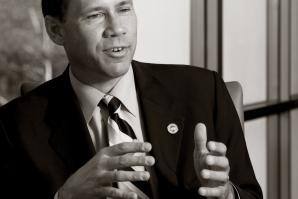Promenade Parkway is a lonely stretch of road south of Elk Grove. Behind a chain-link fence, a steel skeleton of what was supposed to be the city’s first mall with a Macy’s department store and a 16-screen theater sits in the shadow of developer General Growth Properties Inc.’s Chapter 11 bankruptcy negotiations.
The Chicago-based mega-mall owner began construction in 2007 with much fanfare. But it stopped abruptly in 2008 when the changing market left the developer hemorrhaging money. Now the 1.1 million square feet of framed shells at Highway 99 and Grant Line Road is surrounded by dry grass poking through the parking medians.
The court battle between creditors and the developer have resulted in numerous proposals to sell the property for pennies on the dollar to various holding companies. Wherever the deed ends up, shoppers may have to wait a while for a new Cinnabon.
“It’s a soap opera,” says Garrick Brown, director of research for Colliers International. “When the saga will end depends on when the rooftops arrive.”
Brown’s best-case scenario is that a company with deep pockets buys the property and sits on it for four years until Elk Grove — the fastest-growing city in the country five years ago — picks up the residential pace again. Today, Elk Grove’s vital signs are weak with a higher than average foreclosure rate. “Residential growth won’t really happen until job growth brings unemployment below 9 percent,” Brown says.
To speed up development, Laura Gill, Elk Grove’s city manager and redevelopment director, proposed designating the area as blighted to establish a redevelopment zone. This would allow the city to collect incremental taxes that could be used to offer development incentives.
“We may not qualify because the definition of blighted is very specific, but we had to at least look at it,” Gill says.
Existing property owners in other parts of Elk Grove are still feeling the aftershocks of the boom and bust. Vacancy rates for retail property in the fourth quarter of 2009 hovered at more than 12 percent, according to Colliers International. Early reports suggest some of that space was absorbed in big deals at the beginning of the year, Brown says, bringing total vacancy for the first quarter to 10.7 percent. That’s good news, but not enough to bring out the tractors. Although 19,000 more square feet became available in 2009, no retail space over 10,000 square feet is currently under construction, according to Colliers.
Scott Carruth, a senior associate at CB Richard Ellis, says there are signs of life in Elk Grove. He points to retail centers minutes from the Promenade on Elk Grove Boulevard that are thriving. Sure enough, on a recent Sunday, the parking lot was packed at the Calvine Center where a Safeway, Starbucks and CVS attracted patrons. Only one 2,000-square-foot space was available. Similar scenarios can be seen up and down the busy corridor. “The core areas of Laguna and Elk Grove are at or close to capacity,” Carruth says. “It goes to show that if it is a good property, you will find tenants.”
Gregg Mason, vice president of marketing for Jackson Properties Inc., which owns 22,000 square feet of retail at Laguna Point, is also bullish about the city’s economy. “I believe Elk Grove has a bright retail future,” he says.
Some of the big leases signed in the area recently include an 80,000-square-foot Burlington Coat Factory that replaces a former Mervyn’s storefront in Marketplace 99. Henry’s Market agreed to take 35,000 square feet that was a Circuit City in Laguna Gateway.
“It’s a soap opera. When the saga will end depends on when the â?¨rooftops arrive.”
Garrick Brown, director of research, Colliers International
Brown says more of these reuse scenarios could play out in 2010 as a national grocery ramp-up plays out locally. Walmart is looking for 20,000-square-foot, small-format grocery spaces with as many as 10 sites slated for the Sacramento area, including one in Elk Grove. A superstore is already in the works for south Elk Grove.
Target has pledged to ramp up its grocery concept plans with a $1 billion investment to add expanded grocery sections to existing locations nationally. The drug chain Walgreens is testing ready-made items such as salads, fresh-cut fruit and sandwiches along with an expanded beer and wine selection. Even the corner convenience store 7-Eleven is also expanding its food selections.
“All of this doesn’t bode well for unionized traditional grocery stores, and we may end up seeing some consolidation,” Brown says.
It is good news, however, for owners of Elk Grove neighborhood strip centers where vacancies are around 23 percent. They have the smaller spaces that chains such as Grocery Outlet are looking to convert. One Walmart, even a small one, can change the traffic pattern for a strip center that has been vacant for years and lead to leases on the surrounding spaces. “It changes the nature of the center, drives traffic and makes it easier to lease other spaces,” Brown says.
Vacancies may be recovering, but rents are still down. CB Richard Ellis pegged the monthly lease rate for Elk Grove retail at $1.95 a square foot at the end of 2009, down from $2.75 a square foot a year earlier.
After a year of cutting rents to keep existing tenants in place, sometimes for half of what they were previously paying, rates have stabilized. “I think we have hit bottom on renegotiations,” Carruth says.
Mason says, “The drop in rates has slowed, even reversed in some cases.”
These bargain leases are driving expansion plans of national companies who are gaining confidence in the economy and want to lock in low rents and empty existing spaces while they can. “Repurposing existing buildings can help companies sidestep environmental holdups and slow growth issues,” Brown says.
Recommended For You

Balancing the Grove
Elk Grove Mayor Gary Davis on employment-oriented development
In his 2013 State of the City speech, Elk Grove Mayor Gary Davis said his vision for the future was centered on the concept of balance. Without it, he says, the city’s future is unsustainable.

Influence & Alienate
Constituencies balk as Elk Grove prepares for the long haul
Immediately south and southeast of Elk Grove are thousands of acres of mostly undeveloped farmland that officials think the city will someday need. The plan is to add nearly 8,000 acres — about 29 percent of Elk Grove’s current size — to its fold. But critics say Elk Grove has plenty of unused land within its borders, and California is losing farmland fast.



